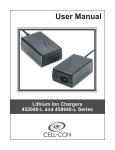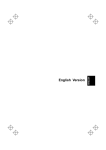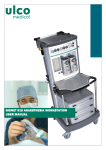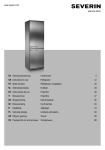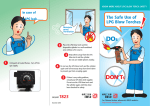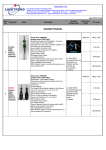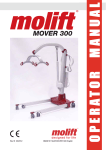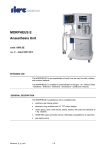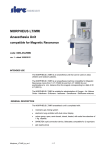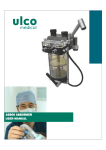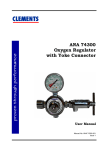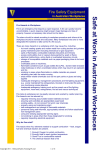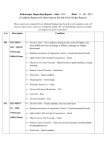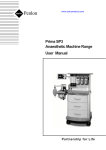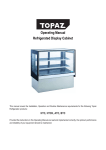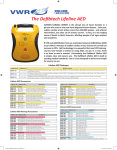Download ANAESTHETIC MACHINE - Frank`s Hospital Workshop
Transcript
ELITE 615 ANAESTHETIC MACHINE Ulco Medical 25 Sloane St Marrickville NSW 2204 USER MANUAL ii Copyright © 2005 by Ulco Medical All rights reserved. No part of this publication may be reproduced in any form, in an electronic retrieval system or otherwise, without the written permission of the Ulco Medical. All Ulco products are subject to a program of continuous development and the manufacturer reserves the right to make alterations in design and equipment without prior notice. Document Number: EL6-UM-001 Version: 1.0 Table of Contents 1 Introduction .......................................................................................... 4 1.1 Restriction ......................................................................................................4 2 Specifications ....................................................................................... 5 3 Warranty................................................................................................ 7 4 Protocol for checking the Anaesthetic Machine ................................ 8 5 Anaesthesia Equiptment Check-out Procedure............................... 13 5.1 Scan the Machine ........................................................................................13 6 Preparation for Use ............................................................................ 17 6.1 Cylinder fitting ( Pin Index ) ..........................................................................17 6.2 Pipeline Hoses .............................................................................................17 6.3 Testing .........................................................................................................17 7 Test Procedure ................................................................................... 19 7.1 Gas supply circuit test ..................................................................................19 7.1.1 Oxygen circuit (cylinder)....................................................................19 7.1.2 Oxygen circuit pipeline ( Fitted as standard) .....................................19 7.1.3 Nitrous oxide (cylinder)......................................................................19 7.1.4 Nitrous oxide circuit pipeline (Fitted as standard)..............................19 7.2 Flowmeters ..................................................................................................19 7.3 System .........................................................................................................20 7.4 Emergency Oxygen Flush............................................................................20 7.5 Oxygen Warning Device ..............................................................................20 7.6 Anti-Hypoxic Device.....................................................................................21 8 Routine Care ....................................................................................... 22 8.1 Cylinder flow control valves..........................................................................22 8.2 Cleaning.......................................................................................................22 8.2.1 8.3 DO NOT AUTOCLAVE......................................................................22 Pipe line hose assemblies............................................................................22 9 Major Components of the Machine ................................................... 23 ii Elite 615 Anaesthetic Machine 9.1 Patient Block ................................................................................................23 9.2 Main regulators ............................................................................................25 9.2.1 Servicing the regulator ......................................................................25 9.3 Second stage regulators ..............................................................................27 9.4 Oxygen failure warning device .....................................................................28 9.5 Anti Hypoxic Device .....................................................................................32 9.6 Flowmeters ..................................................................................................35 10 Additional components of the machine............................................ 37 10.1 Gas Controls ................................................................................................37 10.2 Vaporisers....................................................................................................37 10.3 Ventilator......................................................................................................37 10.4 Soda-lime absorber......................................................................................38 10.5 The anti-hypoxic device ...............................................................................38 10.6 Gas Manifold................................................................................................39 10.7 Pressure gauges..........................................................................................39 10.8 Scavenging ..................................................................................................39 10.9 Auxiliary oxygen outlet .................................................................................39 10.10 Pipeline hose assemblies ............................................................................39 10.11 Patient circuitry ............................................................................................40 10.11.1 The Circle Circuit ...........................................................................40 10.12 Other accessories ........................................................................................40 10.12.1 Accessory power ...........................................................................41 11 Repair and Service ............................................................................. 41 11.1 Service intervals and service components for Elite ‘615’ .............................41 12 Terms and conditions ................................................................... 12-42 3 Elite 615 Anaesthetic Machine Elite 615 and Compact Anaesthetic Machines. The Elite ‘615’ Anaesthetic Apparatus can be easily upgraded from its basic configuration with optional accessories and attachments including full range of patient monitors to provide a comprehensive Anaesthesia workstation. The compact Anaesthetic Machine can also be upgraded from its basic form to include a range of optional accessories and attachments. This manual provides information for preparation, assembly and maintenance of the ‘Elite 615 also allied equipment in the ULCO range of anaesthesia apparatus. Although this equipment has been carefully designed for simplicity of assembly and use, it is recommended that the contents of this manual be studied before attempting preparation or maintenance of the equipment. ULCO or its agents provide a comprehensive service and it is recommended that advantage of this be taken for the safe and reliable upkeep of this equipment. Customers requiring this service or advice with operating problems should contact ULCO or its accredited agents. If equipment is to be attached to the ULCO range of Anaesthesia machines which has not been specifically designed, or supplied by ULCO, it is recommended that customers consult ULCO as to the suitability of the equipment and necessary modifications to the apparatus. WARNING NO OIL OR GREASE OF ANY KIND MUST BE ALLOWED TO COME INTO CONTACT WITH HIGH PRESSURE OXYGEN IN THE USA THIS DEVICE IS RESTRICTED TO SALE BY, OR ON THE ORDER OF, A PHYSICIAN. 4 Elite 615 Anaesthetic Machine Elite ‘615’ Anaesthesia Machine A special version is available for use in MRI units. HEIGHT 1370mm WIDTH 720mm DEPTH 690mm WEIGHT 70Kgs. Not including Vaporiser or Absorber. Standard items supplied with Elite ‘615’ GAS CIRCUITS Pipeline Oxygen & Nitrous oxide (400kPa) And Air With gauges. BACKBAR ASSEMBLY All Back Bar components fitted with 23mm connectors. FLOWMETER 3 Gas (Oxygen, Nitrous Oxide & Air) VAPORISER MOUNTS Selectatec type x 2 COMMON GAS OUTLET Emergency Oxygen flush Patient safety valve Male connector Block with 45 L/Min. flow 50 Cm/H2O 22/15 mm OXYGEN FAILURE Warning device with audio visual warnings DRAWER UNITS 1 x Large drawer 150mm deep & 1 x small Drawer 100mm deep. OPTIONAL ITEMS ADDITIONAL DRAWERS Maximum 2 small drawers. Total of four. VAPORISERS Halothane, Ethrane & Isoflurane (Selectatec Type) 5 GAS FLOWMETER With Air flowmeter tube. 5 Elite 615 Anaesthetic Machine ANTI HYPOXIC DEVICE Prevents delivery of hypoxic mixtures, Maintains 25% O2 flow. M.C.S. VALVE ADE switch selects Bain or Lack Configuration. PAEDIATRIC CIRCUIT Jackson Rees system MAGILL CIRCUIT For spontaneous breathing anaesthesia BAIN ADAPTOR For controlled breathing anaesthesia BAIN CIRCUITS Co Axial circuits for use with Bain Adaptor CO2 ABSORBER 1 or 2 kg. capacity 6 Elite 615 Anaesthetic Machine All Ulco products are guaranteed to be free of defects of workmanship or material for a period of one year from the date of delivery. The following are exceptions to this warranty: 1. Defects caused by misuse, mishandling, tampering, or by modifications not authorised by Ulco or its appointed agents and are not covered. 2. Rubber and plastic components and materials are warranted to be free of defects at the time of delivery. 3. Respiratory volume sensors, fuel cells oxygen sensors have a six month limited warranty. Fuel cell oxygen sensor capsules have a warranty from date of delivery of eight months. 4. Warranty for Durasensors*, is limited to a period of six months from the date of delivery. Oxisensors TM are warranted to be free of defects at time of delivery. Any product which proves to be defective in workmanship or material will be replaced, credited or repaired with Ulco holding the option. Ulco is not responsible for deterioration, wear or abuse. In any case, Ulco will not be liable beyond the original selling price. Goods are subject to the terms of applicable warranty. Defective products will be accepted for return at Ulco’s discretion, and only during the warranty period. Application of this warranty is subject to the following conditions: 1. Ulco or its authorised agents must be promptly notified, in writing upon detection of the defective material or equipment. 2. Defective material or equipment must be returned, shipping prepaid, to Ulco or its authorised agent. 3. Examination by Ulco or its authorised agent must confirm that the defect is in fact covered by the terms of this warranty. 4. Notification in writing, of defective material or equipment must be received by Ulco or its agent no later than two (2) weeks following expiration of this warranty. In order to assume complete protection under this warranty, the warranty registration card, and or periodic manufacturer’s service record (if applicable) must be returned to Ulco within 2 weeks of receipt of the equipment. The above is the sole warranty provided by Ulco. No other warranty expressed or implied is intended. Representatives or agents of Ulco are not authorised to modify or amend the terms and conditions of this warranty. *DURASENSORS and OXISENSORS are Trademarks of Nellcor Incorporated. 7 Elite 615 Anaesthetic Machine This is one of the College Policy Documents of the Australian and New Zealand College of Anaesthetists. The College Policy Documents set down the formal, council-approved guidelines for practice in a wide range of circumstances. Hospitals require these documents to be readily accessible to relevant staff at all times for reference as required. The Policy Documents are also referred to by Government and other bodies, especially in the process of accreditation of health care facilities. The College Policy Document ‘Protocol for checking the Anaesthetic Machine’ reads as follows: 1 Introduction 1.1 The regulated supply of gases and vapours for anaesthesia and the provision of controlled ventilation for the patient are the main functions of the anaesthetic machine or workstation. Because oxygenation and ventilation are essential for every patient and because even a brief failure to maintain them may cause irreparable harm, every machine must be regularly and thoroughly checked to ensure that all functions are correctly maintained. 1.2 There must be a reserve facility to maintain oxygenation and ventilation of a patient should failure of the primary systems occur. 1.3 To ensure early detection of any failure in the anaesthetic machine, it is essential that appropriate alarms are present in the machine and that there is monitoring of the state of the patient as specified in College Policy Document P18 Monitoring During Anaesthesia. 1.4 This protocol incorporates three components: 1.4.1 Level One check. This is very detailed and is required a) on any new machine and b) on all machines after the required regular servicing. This check will usually be performed by the service person – whether from the equipment provider, or from the Bio Engineering Department. 1.4.2 Level Two check. This should be performed at the start of each anaesthetic session. 1.4.3 Level Three check. This should be performed immediately before commencing each subsequent anaesthetic. responsible for Each check must be derived specifically for the machine under test and the Anaesthesia Department ( on behalf of the hospital administration) is The training and accreditation of the personnel involved with each test. 1.5 Accreditation for checking the anaesthetic machine requires: 8 Elite 615 Anaesthetic Machine 2 1.5.1 Level One. Attendance at a manufacturer’s course or a programme developed by the hospital’s Anaesthesia Department in consultation with a qualified Biomedical Engineer. 1.5.2 Levels Two and Three. Checks must follow protocols specifically developed for the machine under test. All personnel must be trained in correct procedures and accredited to perform them by the Anaesthesia Department. The specific protocols should be attached to the machine. Protocols 2.1 Level One check. This must be performed by on anaesthesia machines a) before they enter service and b) following all service inspections, which must be performed at regular and specified intervals. 2.1.1 The Hospital, Anaesthesia Department or body responsible for the equipment shall keep a detailed record of the equipment and the checking procedures. This process requires that a checklist be maintained. The checklist will be based on manufacturer’s recommendations. The protocols shall describe checking and calibration protocols and the intervals at which these must be performed. 2.1.2 The anaesthetic machine must have a prominent label to advise of past service(s) and to indicate when the next check is due. This label must be visible to the anaesthetist. 2.1.3 Gas Delivery System. The check shall include: 2.1.3.1 Quantifying and minimising leaks 2.1.3.2 Excluding crossed pipelines within the machine 2.1.3.3 Ascertaining the correct functioning of non-return valves throughout the system 2.1.3.4 Ascertaining the integrity of oxygen failure prevention and warning devices 2.2 2.1.4 Anaesthetic Vapour Delivery System. The check shall include the accuracy of vapour output and delivery devices. 2.1.5 It is essential to ascertain that the machine as supplied complies with the relevant Australian or New Zealand standard. 2.1.6 The check specified above must be undertaken by a suitably qualified person, usually the service provider. The check must be recorded with inclusion of information as to what was checked, and by whom. After servicing, the particular checklist will relate to the actual service performed. Level Two check. This check must be undertaken by a suitably qualified person (such as an anaesthetist, technician or nurse) in accordance with a protocol specific for the particular machine. Thus several different protocols may be required in a single hospital. These will serve to verify the correct functioning of the 9 Elite 615 Anaesthetic Machine anaesthesia machine before it is used for patient care. Equipment required for the tests must be available on each machine. ` 2.2.1 High Pressure System. 2.2.1.1 Check oxygen cylinder supply. Ensure that cylinder content is sufficient for its intended purpose. 2.2.1.2 Check that piped gas supplies (where present) are at the specified pressures and that following high pressure system checks, the cylinders are turned off. 2.2.1.3 Confirm correct pipeline supply by using an oxygen analyser or multigas analyser distal to the common gas outlet. 2.1.2 Low Pressure System. 2.2.2.1Check control valves and flow meters. Turn on each gas and observe the appropriate operation of the corresponding flow meter. Check the functioning of any interactive anti-hypoxic device 2.2.2.2.Check that any required vapouriser is present: 2.2.2.2.1 Check that adequate anaesthetic liquid is present. 2.2.2.2.2 Ensure that the vapouriser filling ports are closed. 2.2.2.2.3 Check correct seating and locking of a detachable vapouriser. 2.2.2.2.4 positions. Test for circuit leaks for each vapouriser in both on and off 2.2.2.2.5 Ensure power is available for electrically operated vapourisers. 2.2.2.3 Check for pre-circuit leaks using a method sensitive to 100mL/minute and appropriate for specific machine. 2.2.2.4 Breathing systems. Check the general status to ensure correct assembly and absence of leaks. The precise protocol will depend on the anaesthesia circuit to be used. 2.2.2.4.1 Perform leak test on the breathing system by occluding the patient connection, applying a fresh gas flow of 300mL/min and ensuring that a pressure of greater than 30cm H2O is sustained. 2.2.2.4.2 In the circle system check its integrity and the functioning of unidirectional valves. This can be accomplished with a breathing bag on the patient limb of the Y-piece. Ventilate the system manually using an appropriate fresh gas flow. Observe inflation and deflation of the attached breathing bag and check for normal system resistance and compliance. Observe movement of unidirectional valves. Check function of adjustable pressure 10 Elite 615 Anaesthetic Machine limiting (APL) valve by ensuring easy gas spill through APL when the two breathing bags are squeezed. 2.2.3 Automatic Ventilation System. This should be checked according to the manufacturer’s recommendations. This test protocol must be present on the machine. A test lung (such as a suitably compliant bag) may be used to check the function of the ventilator. Where practicable, gas flow should be reduced to check for leaks. The functioning of disconnection and high pressure alarms should be checked at this time. 2.2.4 Scavenging System. This should be checked after connection to APL valve and ensuring a free gas flow. If there is negative pressure in any part of the system, ensure that this does not lead to emptying of the breathing system. With the patient occluded, a full breathing system should not empty with the APL valve open. 2.2.5 Emergency Ventilation System. Verify the presence and functioning of an alternative method of providing oxygen and of controlled ventilation (such as self-inflating bag). 2.2.6 Other apparatus to be used. This should be checked according to specified protocols. Attention should be given to: 2.2.6.1 Equipment used for airway maintenance and intubation of the trachea. 2.2.6.2 Suction apparatus. 2.2.6.3 Gas analysis devices. 2.2.6.4 Monitoring equipment. Special attention should be paid to alarm limits and any necessary calibration. 2.2.6.5 Intravenous infusion devices. 2.2.6.6 Devices to reduce hypothermia during anaesthesia. 2.2.6.7 Breathing circuit humidifiers. 2.2.6.8 Breathing circuit filters. 2.2.7Final check. Ensure vaporisers are turned off and that the breathing system is purged with air or oxygen as appropriate. 2.3 Level three check. Immediately before commencement of each anaesthetic, the anaesthetist should: 2.3.1 Check a changed vaporiser using the protocol outlined in 2.2.2.2. 2.3.2 Check a changed breathing circuit using the protocol outlined in 2.2.2.4. 2.3.3 Check that equipment as specified in 2.2.6 is ready for the next case. 11 Elite 615 Anaesthetic Machine This policy document has been prepared having regard to general circumstances, and it is the responsibility of the practitioner to have express regard to the particular circumstances of each case, and the application of this policy document in each case. Policy documents are reviewed from time to time, and it is the responsibility of he practitioner to ensure that the practitioner has obtained the current version. Policy documents have been prepared having regard to the information available at the time of their preparation, and the practitioner Should, therefore have regard to any information, research or material which may have been published or become available subsequently. Whilst the College endeavours to ensure that policy documents are as current as possible at the time of their preparation, it takes no responsibility for matters arising from changed circumstances or information or material, which may have become available subsequently. Promulgated: 1984 Reviewed: 1990, 1996 Date of current document: Oct 1997 © This document is copyright and cannot be reproduced in whole or in part without prior permission. 12 Elite 615 Anaesthetic Machine !" # $ % The procedure described below is one method of checking out the Anaesthesia machine that will detect almost any serious problem. (Special procedures may be required if the machine has been modified or has special medical equipment attached to it.) The complete check-out procedure or its equivalent should be performed prior to the first time a machine is used each day. The main checks should also be carried out before each use of a machine on a different patient. Ensure that an anaesthetic machine checklist is completed as the procedure is carried out, with all details submitted. Comprehensive pre-use and or daily inspection procedure is a vital component of a complete anaesthesia patient safety program. It must not, however, be relied upon to prevent all equipment related complications. Some types of failures may not be detected without an exhaustive inspection protocol, and some equipment failures will inevitably occur during use. There is no substitute for the continuous presence, vigilance and good judgement of a trained anaesthetist during anaesthesia and mechanical ventilation. Before starting, be sure to have all necessary equipment Start by verifying that the items necessary for the procedure are present. Appropriate EMERGENCY drugs and equipment should be close at hand. Be sure to check Laryngoscopes, as they are the equipment items that fail most frequently. Visually examine the anaesthesia machine to identify obvious problems, such as broken flowmeter tubes or missing probes and breathing circuit connectors. Identify and log the machine serial number on the anaesthetic record as this may be needed if a problem were to be suspected. *PROCEDURE 1. Turn on the monitoring equipment, and allow time to stabilize before calibrating. (O2 Analyser) 2. Connect Scavenging System. (All fittings should be sequential to prevent misconnection). Activate the system prior to carrying out any procedure or check to avoid polluting the Operating Room. 3. Check back bar integrity and selectatec type mounts. Clear all obstructions such as tubes and lines which could prevent correct Vaporiser mounting. 4. Various methods of mounting Vaporiser are currently used such as the OFF LINE or FIXED but the most common is the SELECTATEC type mounting system in which a mounting block is permanently attached to the back bar, and the Vaporiser is locked on by means of DZUS (Aircraft type) quick release fastener. Gas flow is diverted through the Vaporiser via the ports when the Vaporiser is placed on the mounting block. The selectatec system allows for interchangeability of Vaporiser(s), either for the use of an 13 Elite 615 Anaesthetic Machine alternative volatile agent, or for the maintenance and servicing, as well as rendering the Machine “Vapour Free” if necessary. As the Seal between the Vaporiser and the Selectatec mounting block is dependent on an “O” ring retained at the bottom of each of the valve stems, it is important that they be examined each time the Vaporiser is removed from the Anaesthesia Machine. IMPORTANT….. Make sure that only one “O” ring is on each of the mounting’s valve stems. It is recommended that spare “O” rings be kept with each Machine. Vaporisers not attached to the Anaesthesia Machine must be prevented from tipping over, storage racks are available to store unused Vaporisers. Vaporisers should be emptied prior to being moved. NB. Please read separate instruction manual issued with each Vaporiser prior to use. 14 Elite 615 Anaesthetic Machine 15 Elite 615 Anaesthetic Machine 16 Elite 615 Anaesthetic Machine & ' The instruction in this section only details the procedure for connecting the gas supplies. & $ ( )* Optional Item on Elite ‘615’ 1. Check the cylinder for correct gas type. 2. Check that an intact Bodok seal is fitted to the yoke. 3. Remove the seal wrap from the cylinder valve. 4. Open the cylinder valve momentarily to blow any foreign matter from the gas outlet. 5. Insert the cylinder into the apparatus yoke, ensuring that the outlet orifice of the cylinder Valve engages with the inlet of the yoke. Tighten the yoke clamping screw. & + The pipeline hoses are fitted with non interchangeable connectors (Handwheels) suitable for Australian wall outlets or cylinder regulators. Each type of gas hose and handwheels is colour Coded and diameter size indexed. Hoses should be screwed to the appropriate connecting Block on both the supply and the apparatus. Sufficiently tighten to provide a gas tight seal. & , The apparatus is now ready for testing prior to use. All the components and assembly are fully tested prior to despatch from our factorybut may have loosend during transport. Ensure that all components are secure. 1. Fit the gas cylinders or pipeline gas supplies as detailed in Preparation for Use. 2. Test the vaporiser, spacer cone, socket joints and safety valve for leaks by blocking the common gas outlet. Raise the pressure in the backbar using the oxygen flow control valve on the flowmeter until the patient safety valve pressure is obtained. Check for leaks from the outlet back to the flowmeter (a soapy solution can be used to test this). 3. Turn off all gas supplies (clean all traces of soap solution, if used, from the machine). The main components used on Elite ‘615’. 1. The flowmeter(s) with flow control valves if no anti hypoxic device id fitted. (If anti-Hypoxic device is fitted the floe control valves are fitted to the Anti hypoxic device.) 17 Elite 615 Anaesthetic Machine 2. The vaporiser mount is a selectatec type and accepts most brands of vaporiser. 3. The patient block complete with emergency oxygen and patient safety blow off valve is fitted with a non return valve to prevent back pressure to the vaporiser(s). A 22/15mm male connector allows connection of the various circuits or supplies gas to an absorber. 18 Elite 615 Anaesthetic Machine - , - . Before any tests are carried out, it is important to ensure that the cylinders are not leaking around the main valve or the Bodok seal. - /) ( * 1. Connect the cylinder to the yoke of the pin-index unit. 2. Check that the oxygen flow control valve is closed –(do not force in any direction.) 3. Turn cylinder ON and check contents gauge – do not use if less than half full. 4. Turn cylinder OFF and check that the gauge does not drop more than one division in one minute. Should the gauge drop more than one division in one minute, locate the leak and rectify. 5. Ensure that no leaks are present around the cylinders main valve or Bodok seal. - /) (0 * 6. Check as for item 2. 7. Connect oxygen pipeline hose to suitable supply and to the apparatus. 8. Check that the pressure is 400kPa. 9. Check for leaks and rectify should they leaks exist. - 1 ) ( * 10. Connect nitrous oxide cylinder to yoke of pin index unit. 11. Check that nitrous oxide flow control valve is closed. 12. Turn on nitrous oxide cylinder and check relative gauge rise. 13. Turn off cylinder and check that the gauge pressure does not drop more than one division in a minute. Test as in 4. - 1 ) ( 0 * 14. Check that nitrous oxide flowmeter flow control valve is closed. 15. Connect nitrous oxide pipeline hose to suitable supply and to the apparatus. 16. Check that pressure is 400kPa. 17. Test as in 13. - 0 2# 18. According to the gases relevant to the flowmeter tube, turn on the appropriate gas supply. 19 Elite 615 Anaesthetic Machine 19. Rotate flow control valves anti-clockwise to open and check that the bobbin or ball rotates freely and that the rise and fall of the bobbin or ball is free relative to the valve position. 20. Close the flow control valve and ensure that the bobbin or ball returns to the base of the flowmeter tube. 21. Repeat this procedure for each gas, turning off each gas supply after use. NOTE Use the oxygen analyser to ensure that no cross connection of gases has occurred. - # • Connect a manometer with Tee piece to the common gas outlet and occlude the other end of the Tee with the palm of the hand. • Open the oxygen flow control valve carefully to 100mL. Flow is reached. The manometer gauge should indicate at least 40cm/H2O pressure, if this pressure cannot be achieved a leak exists and should be rectified. • Repeat test with vaporiser fitted, and test with vaporiser in the ON and OFF positions. WARNING If the system is gas tight, higher pressures may be achieved and these could damage the manometer gauge if care is not taken. - /) !# 0 • Ensure that oxygen supply is ON. Depress the flush button to check that flow exists. • Connect a 2 litre bag to the common gas outlet, and using a stop watch to time, depress the flush button. Ensure that the bag fills within 3.5 seconds. This ensures flows of 35L/min. - /) 34 • Turn “ON” both the oxygen and nitrous oxide supply (use the pipeline Emergency Oxygen Flush). • Set a flow of 1 litre of oxygen and a flow of 3 litres of nitrous oxide on the appropriate flowmeters. • Turn OFF the oxygen supply and observe the pipeline gauge pressure of the oxygen supply. • When the pipeline pressure drops to approximately 220kPa the whistle should start to sound and shortly after the nitrous oxide flow should cut off (bobbin or ball drops to the base of the flow tube). • The oxygen flow must be maintained and the whistle should sound for at least 7 seconds. It is advisable to have an oxygen analyser fitted to the common gas outlet in order to ensure that the oxygen percentage does not drop to below 21% for the duration of the warning. 20 Elite 615 Anaesthetic Machine • Reinstate oxygen supply and the nitrous oxide flow should resume and the whistle is silenced. • If the test is satisfactory, turn off all flow control valves and their relative supplies. -& %+ ) 34 • With all gas supplies connected, attach oxygen analyser to the common gas outlet. • Turn ON air (if fitted) and open and close flow control valve. The air flowmeter bobbin should rise and fall in the normal way (air is not a hypoxic gas). • Turn ON oxygen and nitrous oxide supplies. • Ensure that the oxygen flow control valve is closed and that no oxygen flow is registering in the oxygen flowmeter tube (bobbin is at the base of the tube). • Open the nitrous oxide flow control valve several turns and observe the nitrous oxide flowmeter tube. No flow should register (the device prevents flows of 100% nitrous oxide). • With the nitrous oxide flow control valve left open and with NO nitrous oxide flow, open the oxygen flow control valve until 1 litre oxygen is flowing. Note that nitrous oxide is now flowing at around 3L/min, and the oxygen analyser is at 25% oxygen flow. • Gradually reduce the flow of oxygen and note that the nitrous oxide is simultaneously reduced while the oxygen percentage remains above 21%. NOTE The anti-hypoxic device is not a mixer - the function of the device is to prevent inadvertant delivery of hypoxic mixtures. The oxygen percentage should be set 5% (21% to 30%). No nitrous oxide flow should be able to be set without first setting an oxygen flow. 21 Elite 615 Anaesthetic Machine 5 $ Before connecting a cylinder of gas to the yoke assembly on an Anaesthetic Machine, inspect the Bodok seal for wear and replace if necessary. When removing an old seal, do not scratch the surface of the yoke screw seating as this can cause gas leaks at high pressure. It is recommended that the Bodok seals only are used for replacements. Cylinder valves should always be opened partially before fitting them onto a yoke to ensure that any dust particles and other foreign matter that can cause damage or explosion are removed. 5 $ 2 44 When a cylinder has been fitted into the yoke, the cylinder valve should be turned ‘on’ gently until fully opened. Sudden high flow and rapid gas expansion create loud noise and may also damage the contents gauge. 5 $ Avoid use of solvents and abrasive cleaning agents. 5 3/1/, ',/$6 7! Rubber Goods Clean and sterilise in accordance with infection control guideline and manufacturers recommendations. 5 #8 The Pipeline hose assemblies are fitted with NON INTERCHANGEABLE connectors at both ends of the hose. Each hose is colour coded to ISO STD for a particular gas. Each hose must be connected to the correct gas inlet and sufficiently tighten to prevent gas leaks. The Anaesthesia Machine is provided with hooks fitted to the top rear of each leg for hanging the hoses. WARNING Compressed gases are dangerous and should be handled with care. NO OIL whatsoever must come into contact with compressed gases. 22 Elite 615 Anaesthetic Machine 9 9 : $# ; The Patient block in its entirety houses the common gas outlet, the emergency oxygen flush and a patient safety relief valve set to relieve at 50cm/H20 pressure (which can be set higher or lower). The common gas outlet is a 22/15mm male stainless steel cone with a weight bearing thread for attaching items such as the fresh gas connecting hose to the CO2 absorber or a Bain adaptor. The patient block can slide along the front rail to the most convenient position where it can be locked into position. Fresh gas from the back bar is supplied to the patient block via the one way valve direct to the back of the common gas outlet which is in turn connected to the patient safety, the safety valve is adjusted to relieve at approximately 50cm/H2O pressure. The emergency oxygen flush is supplied with oxygen direct from the oxygen manifold in the console. When depressed, the oxygen flush flow is set by a metered orifice that leads from the high pressure oxygen side of the flush valve to the common gas outlet. The flow is normally 35 to 75 L/min. Service replacement kit Part No. A307-99 should be replaced at least once a year. 23 Elite 615 Anaesthetic Machine 24 Elite 615 Anaesthetic Machine 9 The regulator, gauge and yoke are assembled in line to reduce the risk of high pressure leaks. The brass yoke bolt (RG203) has the Bodok seal (RG204) attached to it and is fitted with a sintered bronze filter (RG2031) is passed through the Yoke assembly and screwed into the Yoke adaptor body (RG201). The Gauge is attached by the gauge connector (RG202) to the Adaptor body (RG201). A stainless steel banjo bolt (RG206) is used to mount the Regulator main body (RG101) to the adaptor body (rg201) and the use of Dowty seals (RG205) prevent any leaks from occurring. A pressure relief valve (NOT SHOWN) is fitted to the underside of the Regulator body (RG101) and is set to start relieving at 600kPa. 9 4 It is recommended that the Diaphragm (RG103) be replaced every 12 months and a total rebuilt kit (RG1-99) is available and should be replaced on a yearly basis. The kit consists of new Diaphragm, Capsule, Dowty seals and all ‘O’ rings. Springs should be also be replaced every 12 months. NB. Bodok seals must be examined and replaced if necessary every time the Cylinders are replaced. 25 Elite 615 Anaesthetic Machine 26 Elite 615 Anaesthetic Machine 9 There are 2 second stage regulators fitted, one each for the oxygen and nitrous oxide supplies. These regulators are situated down stream from the anti-hypoxic device and flowmeter assembly. They are used to calibrate and fine tune the anti-hypoxic device (see separate instructions). The second stage regulators are also used as a buffer to protect the anti-hypoxic device against any pressure fluctuations that may occur in both the pipeline and the cylinder regulated pressure: Pipeline pressure-415 kPa Cylinder regulated pressure-350-370 kPa Second stage regulator pressures when set to deliver the correct mixtures on the antihypoxic device are usually <220 kPa. This allows for fluctuations in supply pressure of more than 100 kPa before the set flows are affected. 27 Elite 615 Anaesthetic Machine 9 /) 2 4 *Testing the Oxygen failure warning device 1. With all the flowmeter controls fully closed and oxygen supply turned OFF, depress the emergency oxygen flush button to deplete all the oxygen from the system. The visual indicator (Visiwink) on the front of the console should now be RED in colour. 2. Restore the NITROUS OXIDE supply only and turn on the N2O flowmeter flow control. NO nitrous oxide should flow. 3. Close N2O flowmeter flow control. 4. Restore OXYGEN supply, and the whistle should sound for a short duration as well the visual indicator should turn GREEN advising that the oxygen supply is now ON. 5. Attach oxygen analyser to common gas outlet and calibrate to 21% allow time to settle. 6. Set OXYGEN flow to 1L/min. and observe that O2 analyser registers 100% oxygen. 7. Set NITROUS OXIDE flow to 3L/min. and note that the O2 analyser now shows 25%. 8. SHUT OFF all OXYGEN supplies (Cylinder and Pipeline). 9. Depress emergency oxygen flush button gently until the whistle just start to sound then release oxygen flush button. 10. The Nitrous oxide should cut off shortly after the whistle sounds but the oxygen must keep on flowing never dropping below 21% and should rise to near 100%. 11. The whistle should be sounding until the oxygen is totally depleted and the Visual indicator turns RED. *Servicing and calibrating the device It is recommended that the Oxygen Failure warning device have a service kit replacement at least once a year (Part no. A3055-99) After replacement kit (consisting of 2 x springs, diaphragms and ‘O’ rings) has been fitted, the unit has to be calibrated as follows: 1. Attach the test gauge to the oxygen test point in the console. 2. Disconnect the oxygen pipeline from the wall outlet. 3. Shut off all flows. 4. Fit a full oxygen cylinder to the machine and open the cylinder slowly to allow gradual pressure build up. 5. Adjust the main oxygen regulator until the pressure on the test gauge is 220kPa. 6. Loosen lock nut A305512 and adjust the oxygen activating pressure bolt A305541 until the whistle starts to sound (ensure that oxygen is present at the flowmeter). 7. Increase the main regulator pressure gradually until the whistle stops sounding. Note the pressure on the test gauge which should be below 300kPa. 8. Reset the oxygen regulator pressure to 220kPa. 9. Remove the test gauge from the oxygen test point and fit it to the nitrous oxide test point. 28 Elite 615 Anaesthetic Machine 10. Open the nitrous oxide cylinder and check that nitrous oxide cannot flow if the control valve is opened. 11. Loosen lock nut A305512 on the nitrous oxide side and adjust bolt A305513 until the flow just starts. 12. Fit the test gauge to the Oxygen test point and decrease the oxygen pressure to 200kPa. 13. Nitrous oxide flow must stop at approximately 210kPa. Adjust if necessary. 14. The whistle pitch and loudness may be adjusted by means of screw A305521. Carry out the test as described in Testing section. 29 Elite 615 Anaesthetic Machine Ventilator Drive Cut Off Device At the same time the oxygen failure alarm sounds the Ventilator drive Cut Off device is set to activate cutting off the Ventilator drive supply gas if the drive gas happens to be Oxygen. This device is identical to the Nitrous oxide cut off part of the Oxygen failure 30 Elite 615 Anaesthetic Machine device. With a Ventilator attached and functioning, repeat previous oxygen failure test and ensure that the Ventilator cuts off at the same time as the Nitrous oxide. Adjustments are done as per Oxygen failure warning device. Service Replacement Kit Part No. A3056-99 should be replaced at least once a year. 31 Elite 615 Anaesthetic Machine 9 + ) 34 Ulco has devised a unique ANTI HYPOXIC DEVICE which is suitable for use as a remote mounted unit or as a complete unit comprising of the Anti Hypoxic Device together with the flowmeter block fitted with rotameter tubes for Oxygen and Nitrous Oxide. The flowmeter block is fitted with a 23mm female cagemount fitting for connection to any existing anaesthesia machine. Both systems are available from ULCO Engineering Pty. Ltd. For use by O.E.M’s. The device has been so designed as to eliminate inherent faults common in other similar products. With devices of other manufacturer, both the oxygen and the nitrous oxide start to flow as soon as the nitrous oxide flow control is turned on, thus the operator can become accustomed to setting the flows by just using the nitrous oxide flowmeter flow control. This is very well, provided the anaesthesia machine is fitted with an anti hypoxic device, but the majority of anaesthesia machine in use both here in Australia and overseas do not have such a device fitted and therefore the operator can set the machine to deliver 100% NITROUS OXIDE inadvertently. The Ulco Anti hypoxic device prevents this scenario from happening, because with the ULCO device NO NITROUS OXIDE is permitted to flow unless the OXYGEN flowmeter flow control is first turned on. With the ULCO device the NITROUS OXIDE needle valve is held captive by the OXYGEN flow control, although the N2O flow control knob is free to rotate in order to prevent damage if force is applied trying to achieve a flow when no flow is allowed. When correctly adjusted and calibrated the device will prevent the delivery of hypoxic mixtures, oxygen flow should be maintained at 25% nominal flow (+ -5%). The device itself is tamper proof and cannot be interfered with by the operator, but is easy to adjust and calibrate by trained technical staff. 9 0'1$,/1 The device is factory set to deliver 25% +- 5% nominal oxygen flow. If Medical Air is fitted, this is independent of the device and is not considered as a hypoxic gas and cannot dilute the mixture to less than 21% oxygen flow. The workings of the device are simple as can be seen from the diagram, it consists of 2 cartridge assemblies each housing a seat, a needle and spring acting against the needle trying to keep it out of the seat in the open (flow on) position. The oxygen control knob pushes the lever causing it to move on its pivot in an arc. The nearer to the pivot the less the movement on the lever, if we therefore situate the needle from the pivot at a distance of 1:3 ratio the movement of the needle will also be at a 1:3 ratio, and if we place the oxygen needle at 1 and the Nitrous oxide at 3, the Nitrous flow will be 3 times greater than the Oxygen (Oxygen will be 25% of the total flow). Due to differences in gas densities and machining tolerances the 2nd Stage regulators are used to achieve the final desired settings. 9 !, ,1. 13$ 6; ,1., +! 1,+< /=$3!7$! WARNING : The device cannot recognise or differentiate the type of gas, it is therefore imperative that a calibrated oxygen analyser is used when setting and calibrating, and for that matter when in use with a patient. The device is calibrated to deliver NON HYPOXIC mixtures of oxygen and nitrous oxide at a present percentage of oxygen throughout the normal working range. The percentage may vary above or below the setting of the nominal 25% due to various factors, but is normally set so that the oxygen is never less than 21%. 32 Elite 615 Anaesthetic Machine 9 !, ,1. With the correct gases connected to the appropriate fittings of the anaesthesia machine and to the device: 1. Turn the OXYGEN flowmeter control fully OFF clockwise. DO NOT USE FORCE. 2. Turn the NOTROUS OXIDE flowmeter control fully ON anti clockwise. Again DO NOT FORCE. 3. Set Second Stage regulators to deliver maximum pressure, turn fully clockwise. ZERO ADJUST THE NEEDLE VALVES as follows. 4. 5. 6. 7. Connect a flexible tube to the oxygen outlet port of the device and immerse the other end of the tube into a container of water. Loosen the lock nut of the oxygen needle valve cartridge, and unscrew the stud until a leak Just appears, then unscrew stud in to JUST shut off the leak. DO NOT OVER ADJUST. Repeat the above procedure for the nitrous oxide needle valve cartridge. Tighten the lock nuts being careful not to disturb the settings. ZERO ADJUST IS NOW COMPLETE. Setting the Device to deliver the correct percentage 8. 9. 10. 11. 12. 13. Shut off both O2 & N2O Second Stage regulators. Open OXYGEN flowmeter flow control 3 or 4 turns 1080 or 1440 degrees. Leave N2O fully on. Turn Oxygen Second Stage regulators ON (clockwise) slowly until full flow is registered on the flowmeter. LOCK Second Stage regulator. Using the flowmeter flow control turn oxygen flow down to 1L/min. Turn Nitrous oxide Second Stage regulators ON (clockwise) slowly until the flowmeter registers 3 L/min. flow. Lock Second Stage regulators. Test the flows throughout the whole range by opening the oxygen flow control only (N2O should already be fully open). With the Oxygen analyser still connected to the common gas outlet the oxygen % should not be less than 21% throughout the range. Minor adjustments can be made using the Second Stage regulators. 33 Elite 615 Anaesthetic Machine 34 Elite 615 Anaesthetic Machine 9 & 0 2# Having passed through the system, each gas enters the base of the flowmeter via the flow control valve and the anti-hypoxic device if fitted. The flow control valves allow for fine adjustment of the flow rate through each of the flowmeter tubes (rotameters). This ensures that accurate gas mixtures are achieved. When the flow control valve(s) is(are) opened, the gas continues at low pressure upward through the flowmeter tube, whose float responds to indicate the rate of flow in litres per minute or parts thereof. Note that the rate of flow is indicated by the top edge of the float (bobbin) against the flowmeter scale. Indicated flows are accurate to within 1.875% of indicated flow +0.625% of indicated reading. Therefore, for a flowmeter with a full scale reading of 10 L/min set to deliver 7.5 L/min, the maximum permissible error is: ± ((7.5 × 1.875 ) + (10.0 × 0.625 )) L/min 100 = ±((0.141) + (0.063 )) L/min ≡ ±0.204 L/min Gases passing through the flowmeter mix together at rates of flow selected by the anaesthetist. Passing along the backbar, the combined gases enter the vaporiser inlet (if fitted). If the vaporiser is fitted and is in the OFF position, the gases bypass the vaporising chamber and pass directly to the common gas outlet via the non-return valve fitted in the terminating block of the backbar. From here they pass to the anaesthetic equipment and to the patient. If the vaporiser is selected ON, gas mixtures entering the vaporiser collect a proportion of the anaesthetic agent from the vaporising chamber within. The percentage volume is determined by setting the vaporiser control at the percentage figure calculated by the anaesthetist. Having passed through the vaporiser, the gas mixture now combined with the anaesthetic agent again enters the backbar and is delivered to the patient as described previously (see the vaporiser manual for further details). Access to the flowmeter tubes is simply a matter of removing the grub screw at the top front of the flowmeter and lifting the protective acrylic cover up and out. Take hold of a flowmeter tube, and lift it gently until it clears the Base block. The tube is then angled outward carefully and pulled down and out. Service replacement kit Part No. A3047-99 or A5047-99 (3 or 5 Gas) 35 Elite 615 Anaesthetic Machine 36 Elite 615 Anaesthetic Machine > # # > . $ On the left had side of the control console are the gas flow controls and rotameters. Gas controls can be differentiated by their shape and colour. The white oxygen (O2) control is furthest to the left and to international design standards. The nitrous oxide (N2O) control is dark blue and air is black and white. The basic Elite 615 is a three gas machine with one tube each for oxygen, nitrous oxide and air. The machine can also be supplied as a three gas, five tube machine with two tubes for nitrous oxide and oxygen. It can also be supplied with only two tubes – nitrous oxide and oxygen. > 7 Various methods of mounting vaporisers are currently used such as the ‘off line’ or ‘fixed’ systems. The most common is the ‘Selectatec’ type mounting system in which a mounting block is permanently attached to the backbar, and the vaporiser is locked on by means of DZUS (aircraft type) quick release fastener. Gas flow is diverted through the vaporiser via the ports when the Vaporiser is placed on the mounting block. The Selectatec system allows for interchangeability of vaporiser(s), either for the use of an alternate volatile agent or for maintenance and servicing, as well as rendering the machine ‘vapour free’ if necessary. Vaporisers can be easily mounted on the back bar via the Selectatec mounting and should be securely locked into place. Vaporisers not attached to the anaesthesia machine must be prevented from tipping over. Storage racks are available to store unused vaporisers. Vaporisers should be emptied prior to being moved. 1 ? # 4 # 2 4 > 7 The ventilator can be mounted to either the left or right hand upright of the machine. The ventilator mount fits into the bracket. All parts can be tightened into position with locking screws. The base plate is fitted to the mount, and the ventilator is then secured to the base plate with the four nylon screws supplied. The ventilator drive hose can then be connected. The drive gas connection for the ventilator is the last gas inlet on the right of the gas manifold. Air or oxygen drive are optional. The ventilator drive gas inlet is supplied with the correct gas hose and ring index for the drive gas specified eg. oxygen. Note that the ventilator silencer is connected to the back of the ventilator and that the 30mm male scavenging outlet is on the top of the exhaust. 37 Elite 615 User Manual Further information regarding the operation of the EV500 ventilator can be found in its user manual. > % # 8 8 The soda-lime absorber mount bracket attaches to the post towards the front of the machine. The absorber mount sits over the upright and should be allowed to seat itself into position. The top locking screw and side locking screw can then be fastened to hold in position. The exhaust hose can then be attached to the 30mm exhaust valve scavenging outlet. The absorber fresh gas hose from the common gas outlet can now be connected to the fresh gas inlet on the side of the absorber. This connection hose is made from strong teflon reinforced nylon hose so it will not perish. No latex tubing is used in Ulco machines. > , % ) 4 The Elite 615 contains many features to ensure patient well-being. The first of these is the anti-hypoxic device. This is a now mandatory device in Australia and many overseas markets. This allows the anaesthetist to deliver 100% oxygen to the patient but never less than a nominal 25% oxygen in the presence of nitrous oxide in the mix. This also means that no nitrous oxide can flow without oxygen. Other devices sometimes allow oxygen flow once nitrous oxide has been turned on. No Ulco machines allow this, meaning that oxygen flow must be established before nitrous oxide. The device is suitable for use as a remote mounted unit or as a complete unit comprising the anti-hypoxic device together with the flowmeter block (consisting of rotameter tubes for oxygen and nitrous oxide). The flowmeter block is fitted with a 23mm female cagemount fitting for connection to any existing anaesthesia machine. Both systems are available from Ulco for use by O.E.M.s. The device has been designed to eliminate inherent faults common in other similar products. In some such devices, both the oxygen and nitrous oxide begin to flow as soon as the nitrous oxide control is turned on. The operator can thus become accustomed to setting all flows whilst only using the nitrous oxide flow control. This is a safe practise assuming the anaesthesia machine is fitted with an anti-hypoxic device. Many machines both in Australia and overseas, however, do not have such a device, enabling the operator to deliver a 100% nitrous oxide flow inadvertently. The Ulco anti-hypoxic device prevents this by ensuring that no nitrous oxide is permitted to flow unless the oxygen flow control is first turned on. The nitrous oxide needle valve is held in place by the oxygen flow control. The nitrous oxide flow control knob is free to rotate, however, in order to prevent damage if force is applied trying to achieve a flow when no flow is allowed. When correctly adjusted and calibrated, the device will prevent the delivery of hypoxic mixtures, and oxygen flow will be maintained at 25% nominal flow ( 5%). The device itself is tamper proof and cannot be interfered with by the operator, but is easy to adjust and calibrate by trained technical staff. 38 Elite 615 User Manual >& . The gas manifold is fitted to the rear of the machine. All gases that supply the machine are connected via the manifold. Pipeline air, nitrous oxide and oxygen are connected from the wall, as well as all pin index reserve cylinders. All yokes are pin-indexed, and once cylinders are located, can be secured into position. The clip mounted cylinder spanners are designed to fit the cylinder valves, and make it possible to reach through and turn on the reserve cylinders from the front of the machine. The Elite 615 is fitted with colourcoded ring indexed gas hoses for wall gas supply: white for oxygen, blue for nitrous oxide and black and white for air. >Pressure gauges are well placed just above the working surface. The top row shows pipeline pressure, while the bottom row shows the pressure in the reserve gas cylinders. A simple visible indicator called the Visiwink is mounted on the right. When green it indicates oxygen is ON. When red it indicates that oxygen pressure is OFF. >5 4 On the left-hand upright of the frame is the scavenging block, which should be connected to wall suction. Adequate scavenging can be achieved by adjusting the ball to the marked line. Vacuum adjustment is via the control at the front. The vacuum reservoir for scavenging is integrated into the frame of the machine using both the frame upright and the supporting member cross-bar. The scavenging block has two locations for pink/red scavenging tubing to be connected. If only one is being used, the other can be sealed by using a bung (supplied). The vacuum tubing is then connected to the outlet tubing on the back of the block. >9 ) ) An auxiliary oxygen outlet is mounted on the right-hand frame upright where an oxygen flowmeter can be used. In this way oxygen can be delivered to the patient, instead of using the rotameters and standard common gas outlet. This is used, for example, with neurolipse (?), relative analgesia and local anaesthesia, safely bypassing the possibility of accidental vaporiser delivery or in-circuit complications. The 0-15 L/min flowmeter can then be connected to the auxiliary outlet. It should be tested to make sure it is operating correctly. > >............... #8 > The pipeline hose assemblies are fitted with non-interchangeable connectors (handwheels) at both ends of the hose. They are suitable for Australian wall outlets or cylinder regulators. Each type of gas hose and handwheel is colour coded and diameter size indexed to the ISO (International Standards Organization) standard for that particular gas. Each hose must be connected to the correct gas inlet and sufficiently tightened to prevent gas leaks. The anaesthesia machine is provided with hooks at the top rear of each leg for hanging the hoses. 39 Elite 615 User Manual > ............... ULCO manufactures many different types of patient circuitry. All are connected to the fresh gas line from the common gas outlet. The first circuit is the Magill’s circuit or Mapleson A. It is a spontaneous breathing circuit and is supplied with a mask. The exhaust valve is fitted with a scavenging connector. The second circuit is a Bain or Mapleson D or E. Again, a scavenging connector is fitted. The third circuit is the paediatric circuit which goes by many names and comes in many different configurations from many manufacturers. It is suitable for small children and neonates and comes supplied with three masks. The circle circuit, however, is the most common option. > ............, , $ $ For this the absorber is connected to the common gas outlet. Ulco has two different configurations for absorbers. Version 1:Ulco absorber 1 or 2kg model without auto/manual (bag/vent) switch. This version utilises the same limb to either connect the ventilator or the manual bag. Version 2:Ulco absorber 1 or 2kg model with bag/vent switch (Part No AB 600 or AB 600LF). This version has separate limbs for the ventilator and manual bag and selection is made by switching the lever either to the bag or vent position. This version eliminates the need to remove the manual bag from the single limb to attach it to the ventilator. Both versions can be fitted with the optional Manometer gauge (Part No AB 400) and low flow APL valve. > .............../ / The mounting of patient suction jars and other accessories can be achieved two ways. Firstly, a second post can be installed as mentioned previously, or a simple mount can be secured to the side of the upright that can accommodate most modern suction bottle mounts. Another accessory which can be supplied on the side is a fold-down writing tray. This is attached by a simple quick locking mounting block on the rail on the side of the work area. The tray can be secured in a horizontal position by swinging the arm brace out from under the tray. Many other accessories can be mounted on the rail via this method, for example, a universal circuit support arm able to swivel in many directions. The lock screw on the side can control excessive movement. 40 Elite 615 User Manual Hooks are mounted on each frame upright and a movable sphygmomanometer mount is positioned on the top monitor tray. An aneroid or mercurial sphygmomanometer can then be used. > ............ 2 The Elite 615 can be fitted with an optional six outlet powerboard at the top rear of the machine. The powerboard is designed to suit Australian standard plugs and is protected by an earth leakage circuit breaker or ELCB. On the bottom right hand corner is a fitting for E P Earth. If the six outlet power board is supplied, two of the outlets may need to be used to power some of the operational features of the Elite 615. Firstly, the rotameter backlighting is supplied with a short power cord that connects to the back of the rotameter housing and requires connection. Secondly, the ventilator power cord may also be connected here leaving the other four outlets for the operator’s own requirements, eg. patient monitoring. 4 Repair of this equipment must be performed by an authorized ULCO Technical Service Representative. ULCO Products in need of factory repairs must be sent to the nearest local agents or direct to ULCO. ULCO RECOMMENDS THAT anaesthesia machines be serviced at twelve (12) months intervals. 4 Item No. 1. 2. 3. 4. 5. 6. 7. 8. 9. 10. 11. 12. 13. 14. 4 4 # ! @ & A Product. Interval in Months. Anti Hypoxic device 12 Rotameter 2 Tube 12 Rotameter 3 Tube 12 Rotameter 5 Tube 12 Selectatec Block 12 Regulator (Primary) 12 Regulator (Secondary) 12 Oxygen Failure Alarm 12 Ventilator Drive 12 Manifolds 12 Patient Block 12 Scavenge Block 12 Elite ‘615’ Service kit – 3 TUBE 12 Elite ‘615’ Service kit – 5 TUBE 12 Qty 1 1 1 1 2 3 2 1 1 3 1 1 1 1 Part. No. AHD10-99 A2047-99 A3047-99 A5047-99 A3046-99 RG1-99 RO7-99 A3055-99 A3056-99 A3057-99 A307-99 A3027-99 A300-99 A500-99 41 ,# All merchandise to be returned must have prior written authorisation by Ulco, and a valid Return Goods Authorisation (RGA) number shall appear on the shipping label, packing slip, purchase order and any other related documents. When requesting authorisation to return material, the following information should be provided: 1. Customer purchase order and date. 2. Ulco invoice number and date, and method of shipment (available form delivery document). 3. Part number, quantity, and description of goods to be returned. 4. Reason for returning goods. The following are acceptable reasons for return of goods: 1. Material failure within warranty period. 2. Service or repairs. 3. Ordered in error or duplication of order. Any shipping errors or shortages of goods must be reported to Ulco within seven (7) days of receipt of such goods. Goods are subject to any terms of any applicable warranty. Premature failure of products shall be accepted for return at Ulco’s discretion, and only during the warranty period. Goods to be returned which are not under warranty should have been purchased within thirty days of request for return, and returned within thirty days after request. Goods shall be returned unused, and in Ulco containers. Goods may be subject to a 20% restocking charge, with the exception of goods failure within the warranty period or due to Ulco error. The following merchandise is not eligible for return, unless proven defective: 1. 2. 3. 4. Sterile material, unless shipped in error by Ulco. Rubber and plastic components that have been used. Specially ordered or produced items. Goods that have been altered or abused. All items to be returned shall be shipped, including RGA number, to: Ulco Medical 25 Sloane St Marrickville NSW 2204 Australia 42 GOODS RETURN AUTHORISATION RGA Number Customer Details Name Address State/Country Postcode Returned Product Date of Purchase Date of return Reason for returning goods (please give a short description of the fault): Signature Return to ULCO Medical 25 Sloane St Marrickville NSW 2204 Australia Always obtain RGA number from ULCO prior to returning goods. ULCO MEDICAL COMMISSIONING REPORT This report is to be filed in the hospital’s Equipment validation file, and a copy returned to Ulco. If any major non-conformances are detected during commissioning, please contact: The Quality Manager Ulco Medical 25 Sloane St Marrickville, NSW, 2204 Ph 02 95195881, Fax 02 9550 2841 MODEL NO. SERIAL NO. CUSTOMER DATE Connect the unit to a power supply and fit the three gas cylinders. Note: The pressure in the cylinders must be 10 000kpa or more. 1 Check the unit for marks or damage 2 With each cylinder in turn, open the cylinder valve until the system is full, then turn the cylinder off. The pressure must not drop more than 1000kpa in one minute. 3 Oxygen Failure • Fit an oxy gauge to the auxiliary oxy outlet, fill the oxy and nitrous systems, turn off the oxy supply and set the nitrous flow to 1 l/min. • Using the oxy flush button on the FGO, gradually drain the oxy system. The alarm must start sounding at 220 kpa The nitrous flow must cease within 5 secs of the alarm sounding 4 Anti hypoxic device • Check that flowmeters operate over their full range • With oxy flow at zero, fully open the nitrous flow control. Nitrous flow must be zero Open oxy to 0.3 l/min, nitrous = 0.9 l/min Open oxy to 0.5 l/min, nitrous = 1.5 l/min Open oxy to 1.0 l/min, nitrous = 3.0 l/min Open oxy to 2.0 l/min, nitrous = 6.0 l/min All readings are to be +/- 15% 5 Fresh gas outlet blow-off • With an oxy flow of 1.0 l/min, occlude the FGO. The blow-off valve must operate at 50 cm H2O With a flow of 0.1 l/min, the valve must operate at between 45 & 55 cm H2O 6 Scavenging Connect the pink scavenging tube and turn on the scavenging valve until the centerline of the ball reaches the datum mark on the scale. Ensure that the ball position is maintained. 7 Absorber checks Connect the FGO to the absorber inlet elbow. Connect the manometer tube to the quick connector. Connect the interface tube (if fitted). Connect the absorber outlet to the ventilator. Fit a circle breathing circuit with a 2l bag on the “Y” connector. Set oxy flow at 0.3 l/min, and ratio at 1 : 2. Check that the ventilator functions Check that the manometer on the ventilator reads tha same as the manometer on the AM. Check that the bag on the breathing circuit inflates and deflates in time with the ventilator. 8 Ventilator checks With the unit connected to the anaesthetic machine, and the outlet elbow plugged, turn the selector switch “ON”. Should get: • Digital display • Bellows should operate • Limit bar graph should operate Check that the bellows operates to the full extent of the volume control Turn the selector switch to “OFF”. Bellows should not descend. Turn the selector switch “ON” and fully open the inspiatory valve. 60 cm H2O should be achieved. Turn the selector switch to “CPAP”. Should be a constant 20 cm H2O. Check that the alarm operates both under and over limits. Check the minimum and maximum inspiratory times and rates: • Insp time 0.1 – 3.0 secs • Exp time 0.1 – 16 secs • Rate 3 – 250 bpm Disconnect mains power ant turn selector switch “ON”. The unit must operate All readings +/- 10% Commissioned by: ............................................. Date:














































